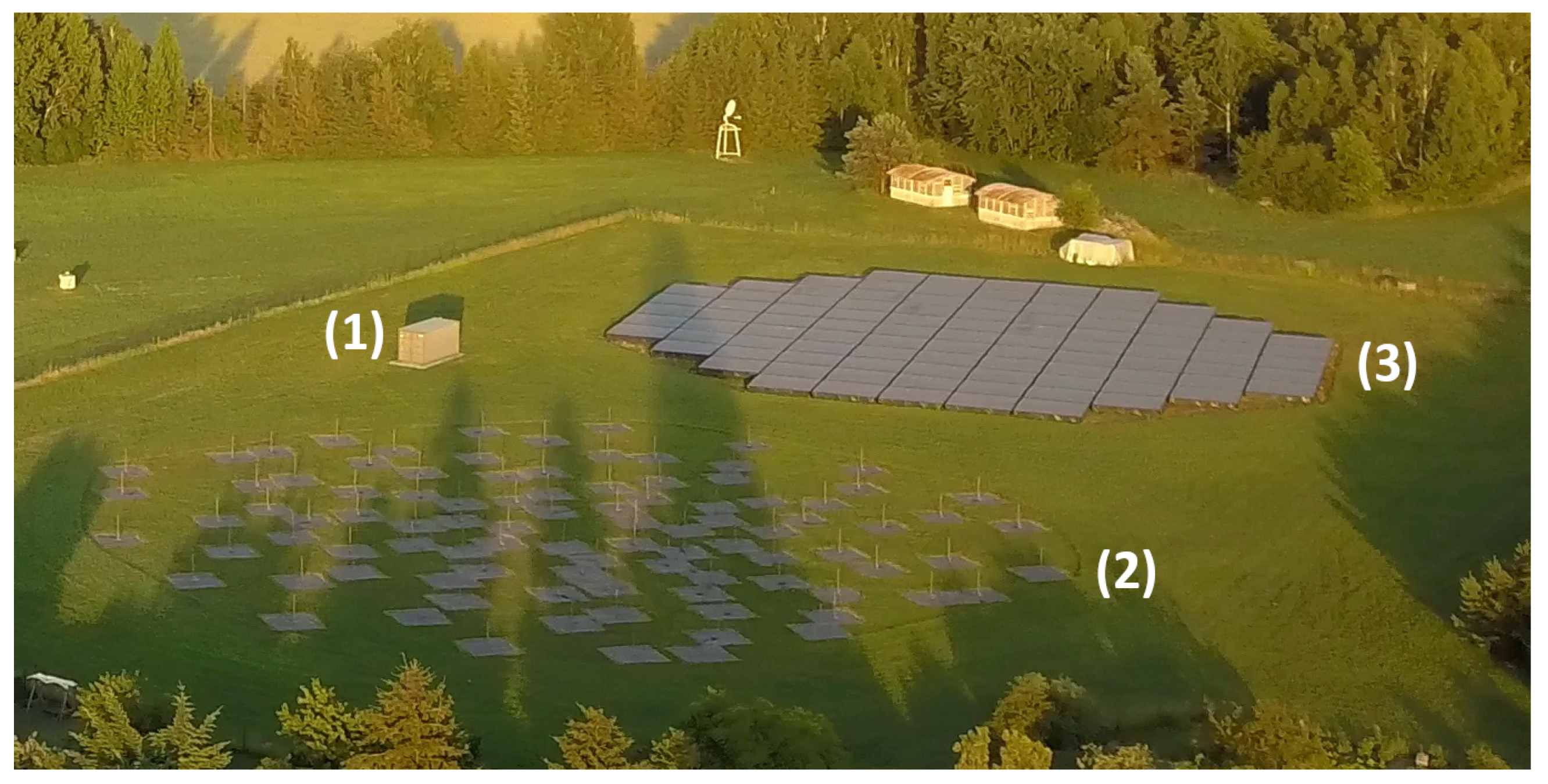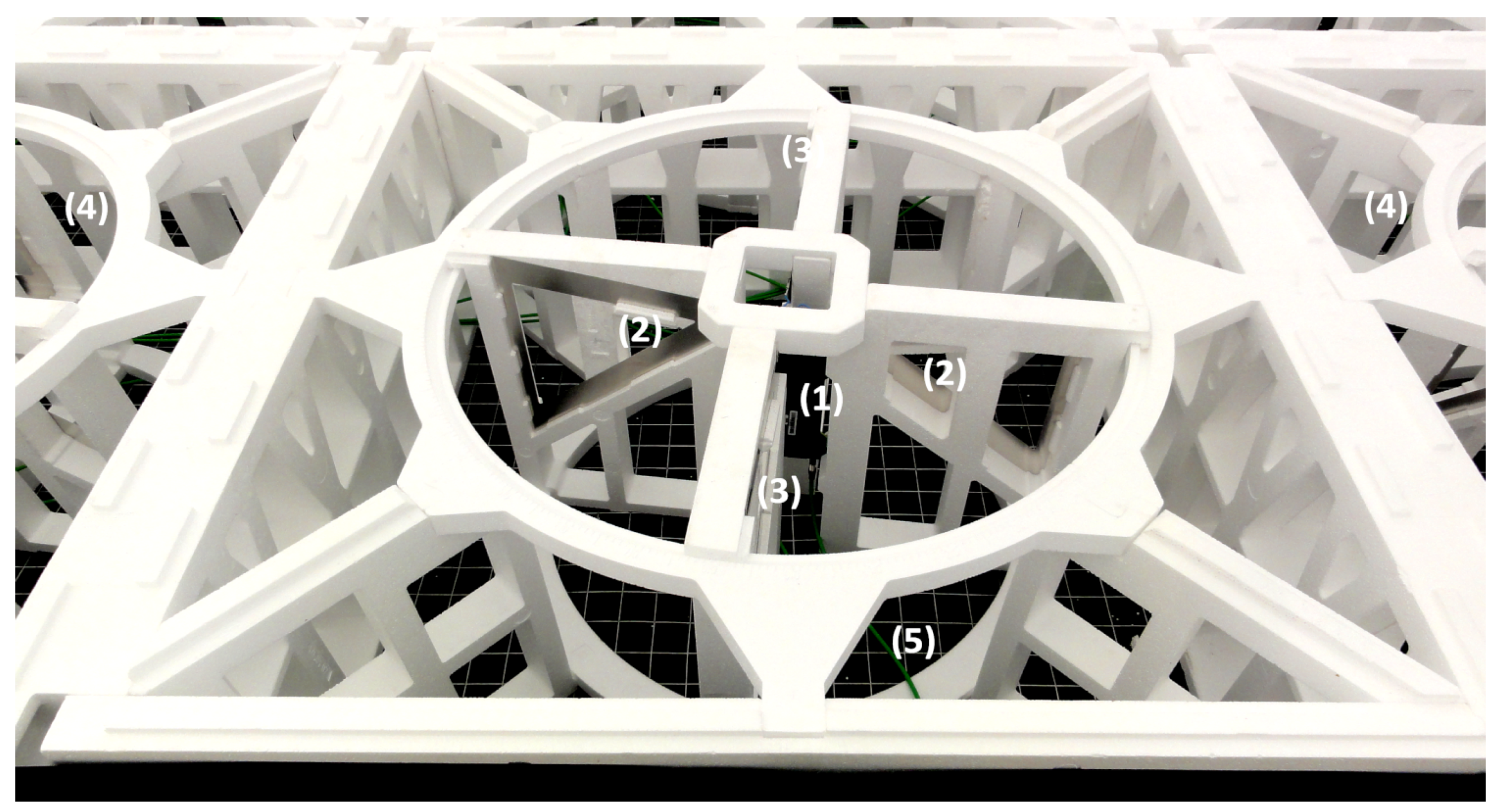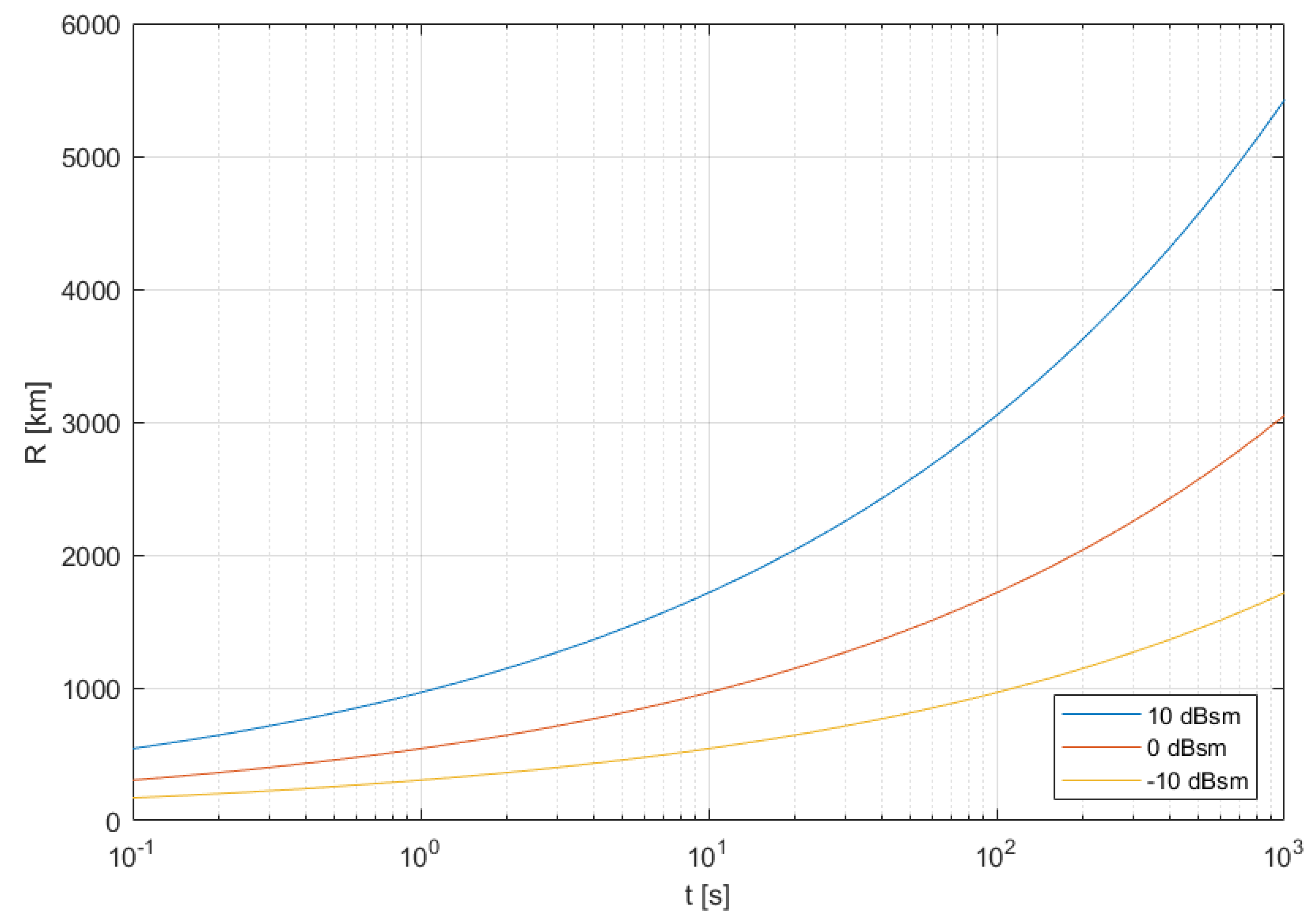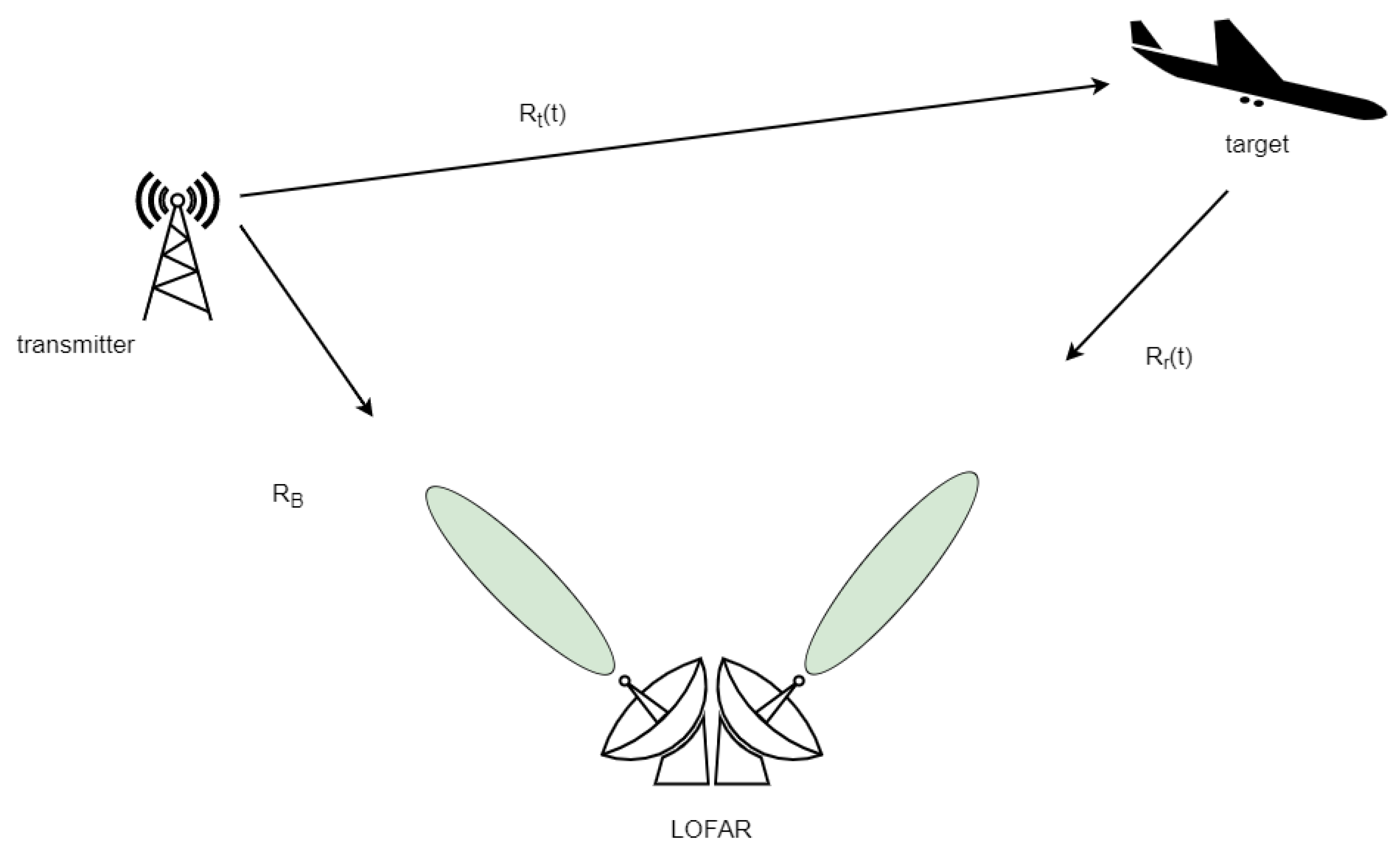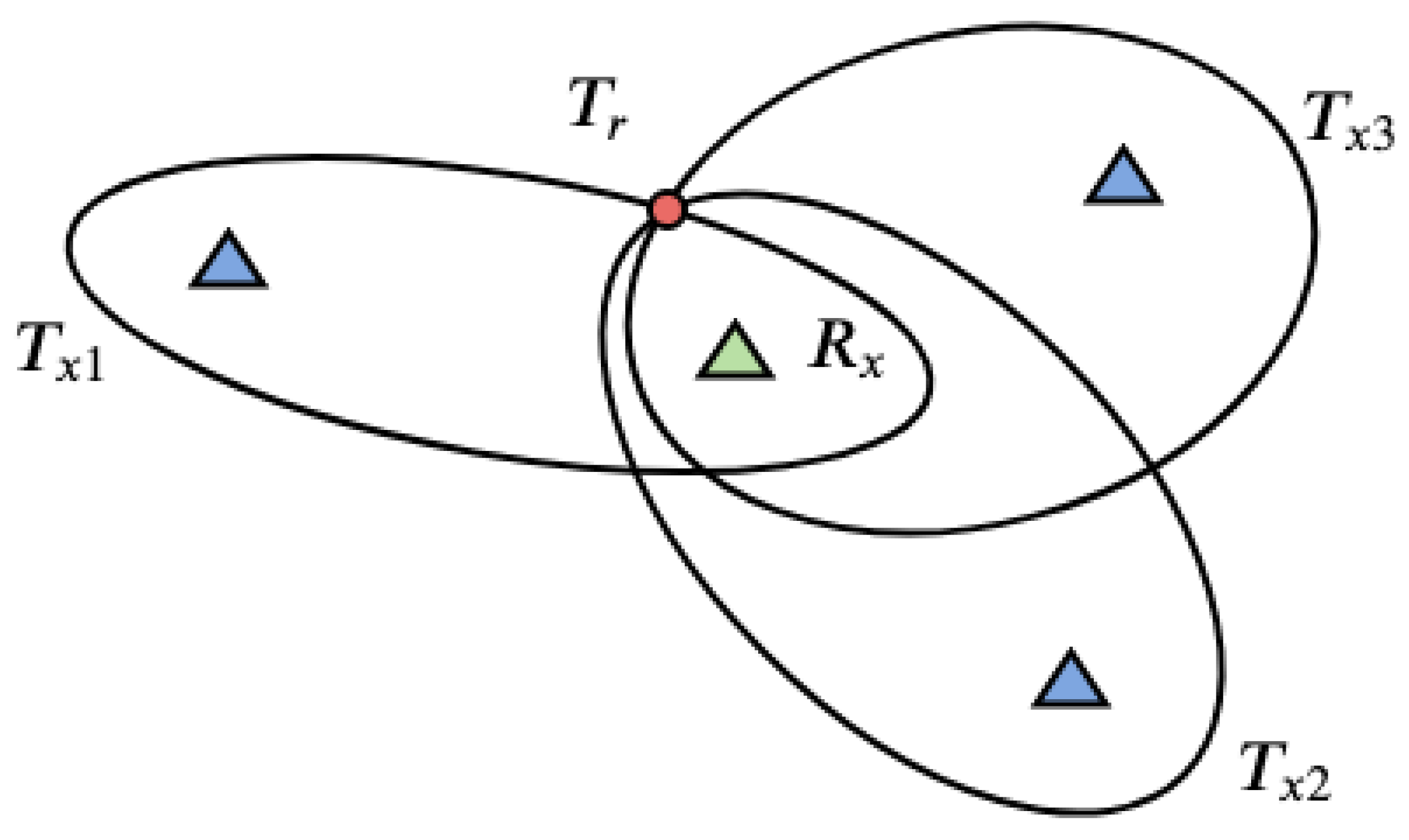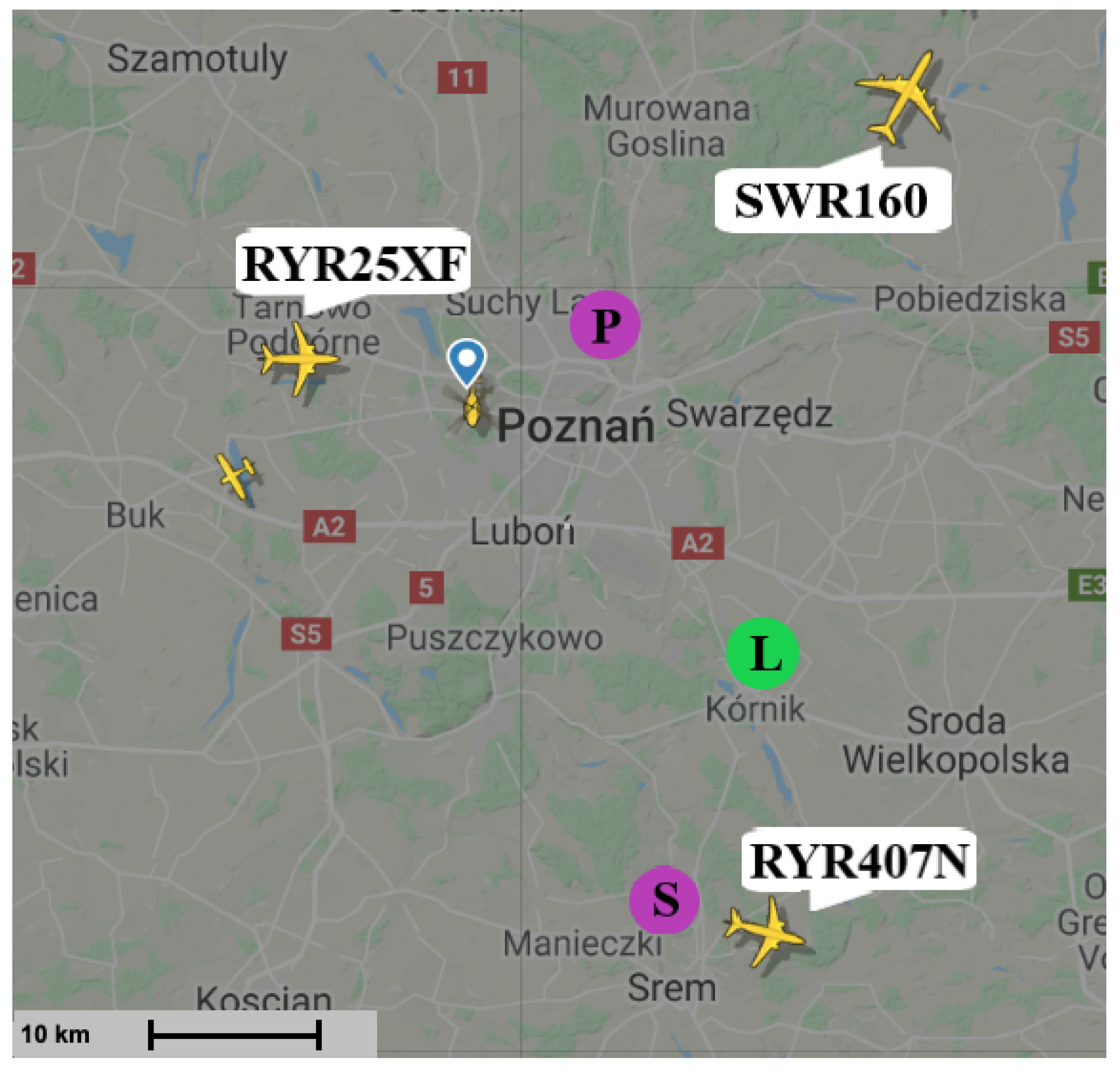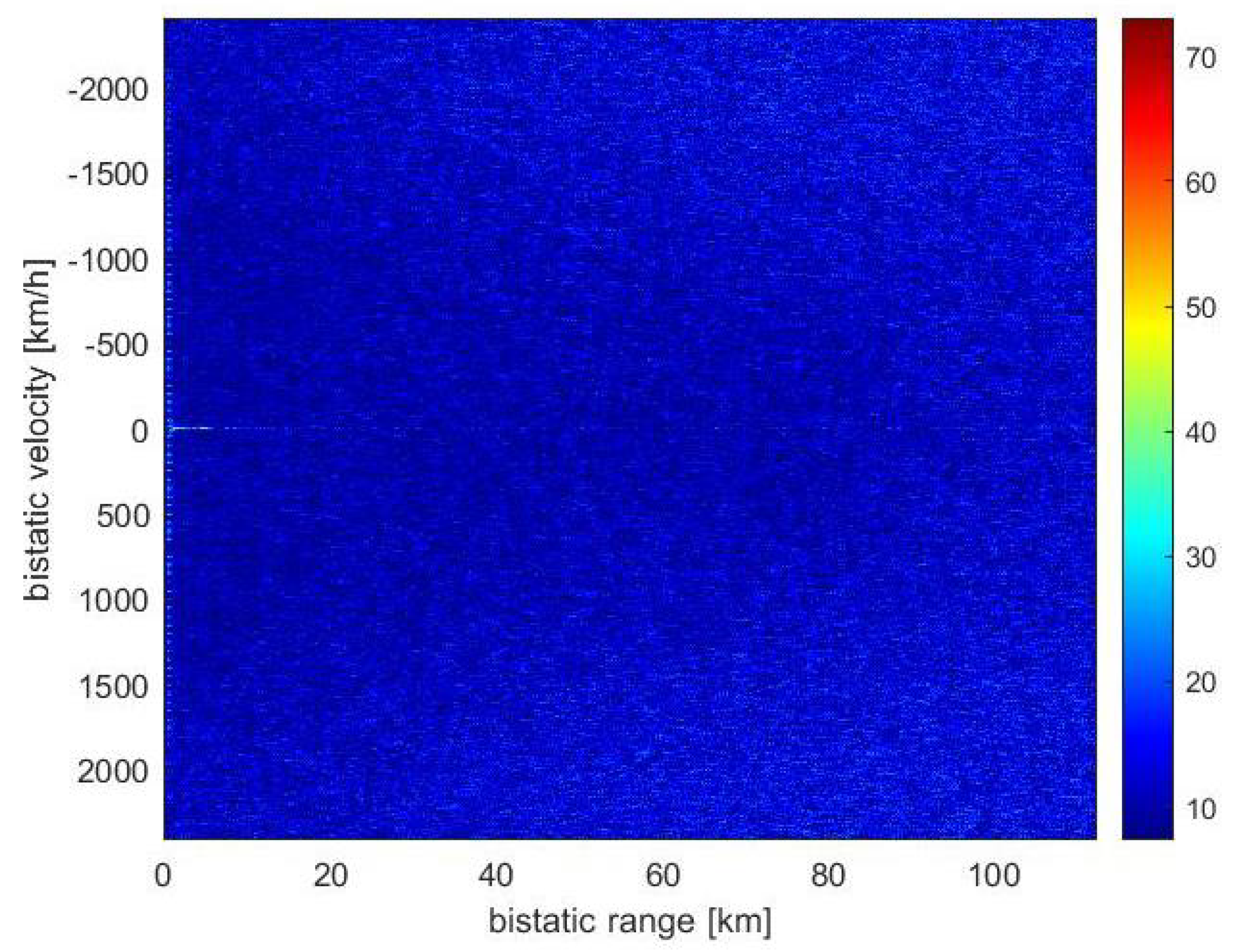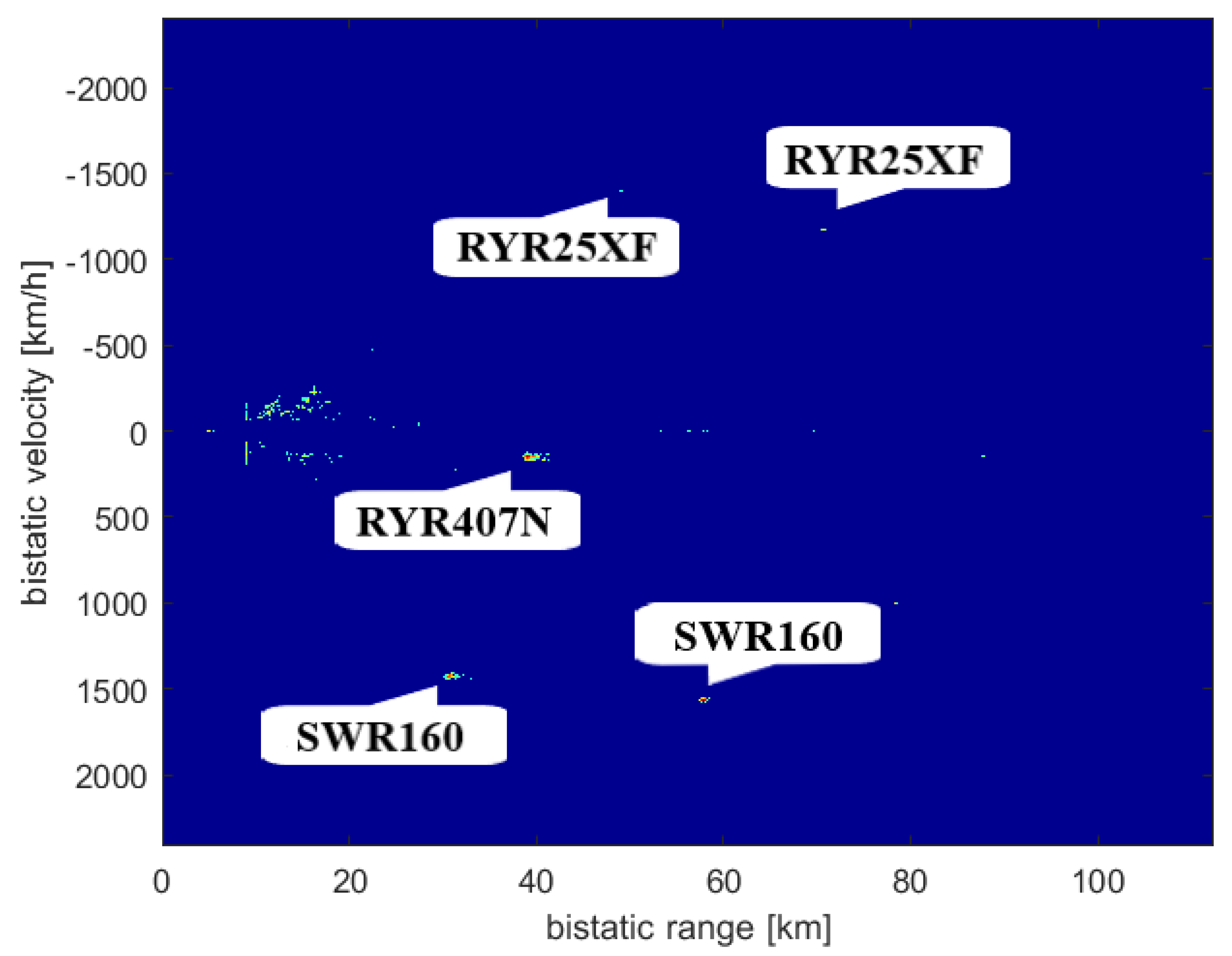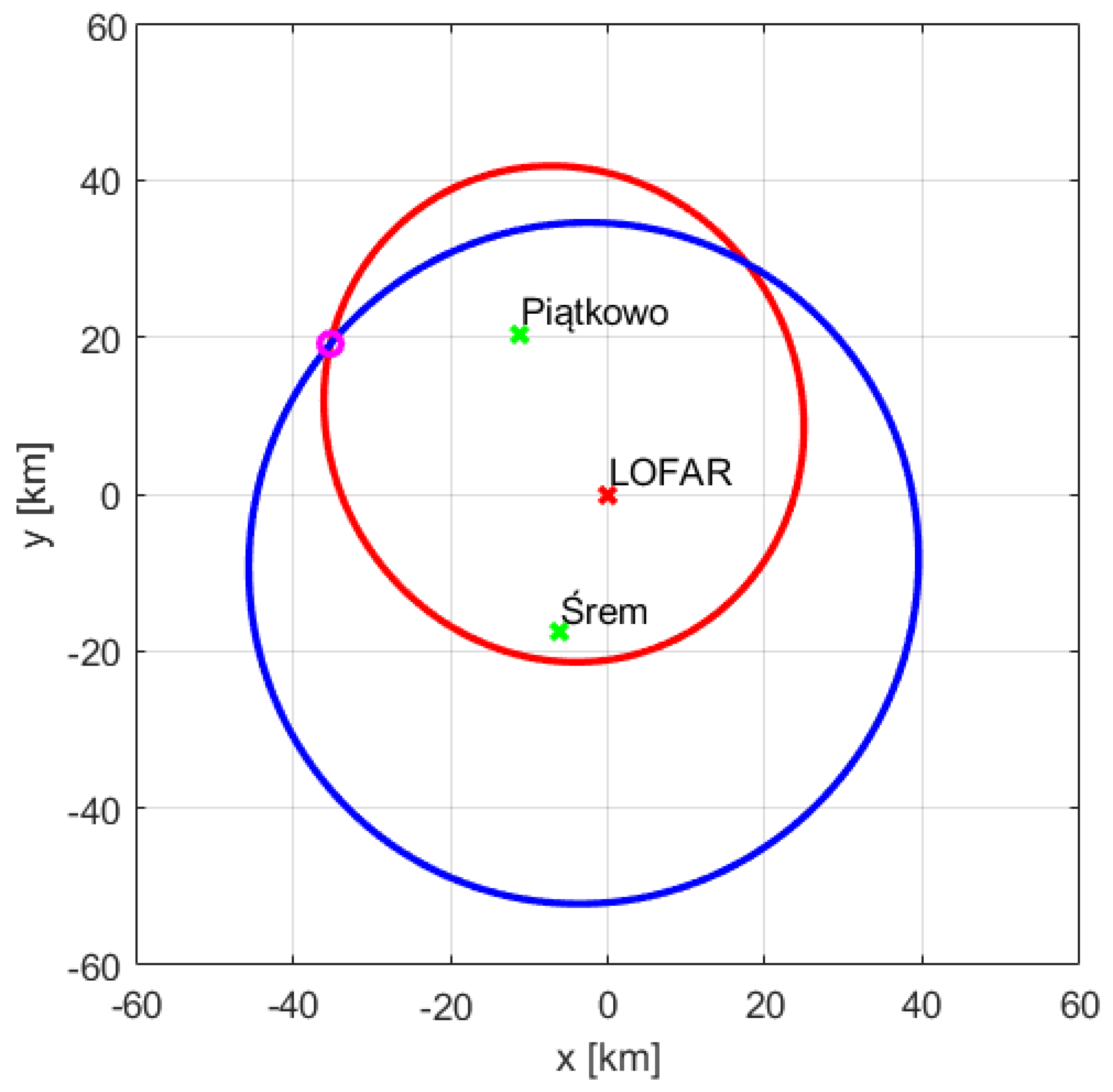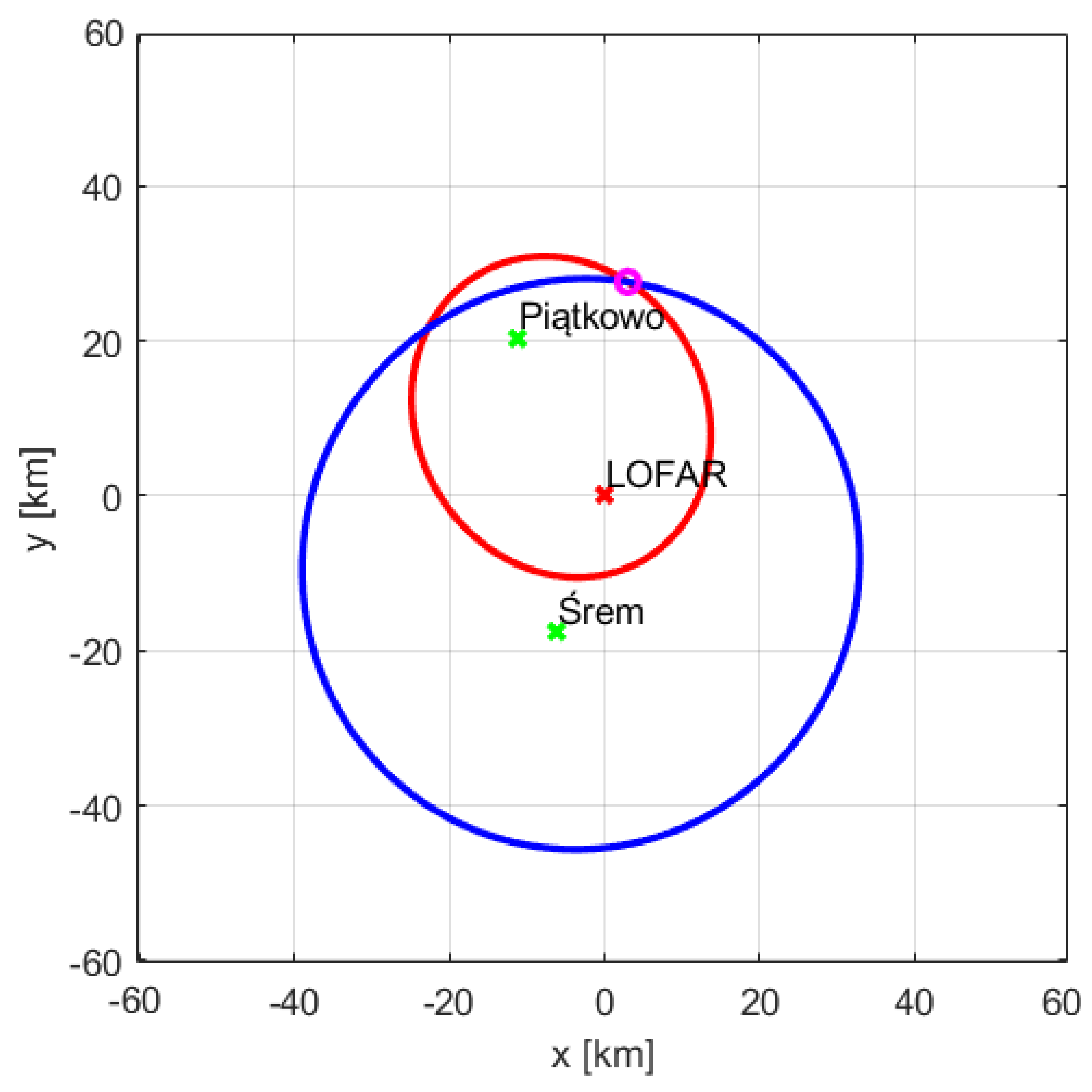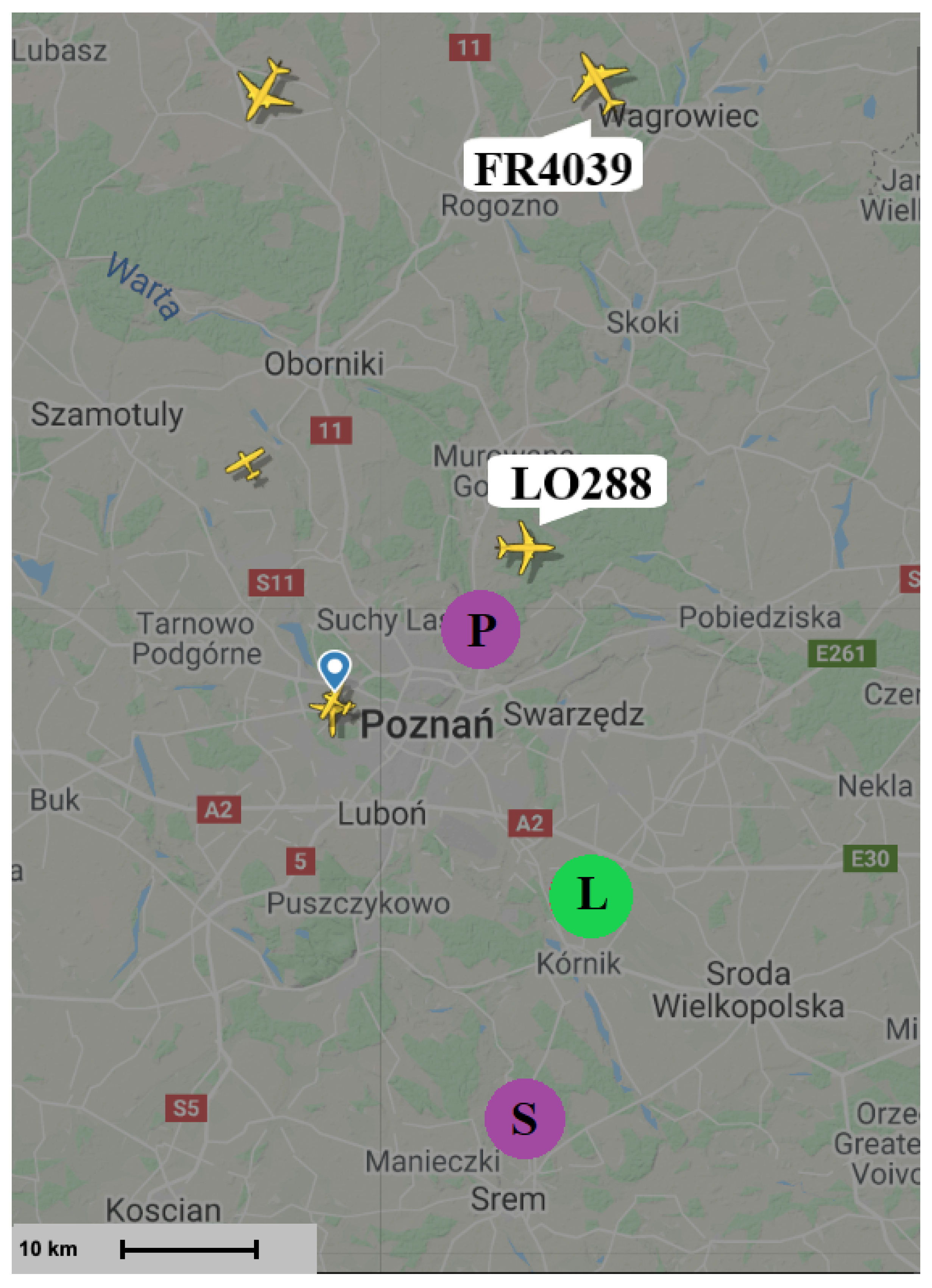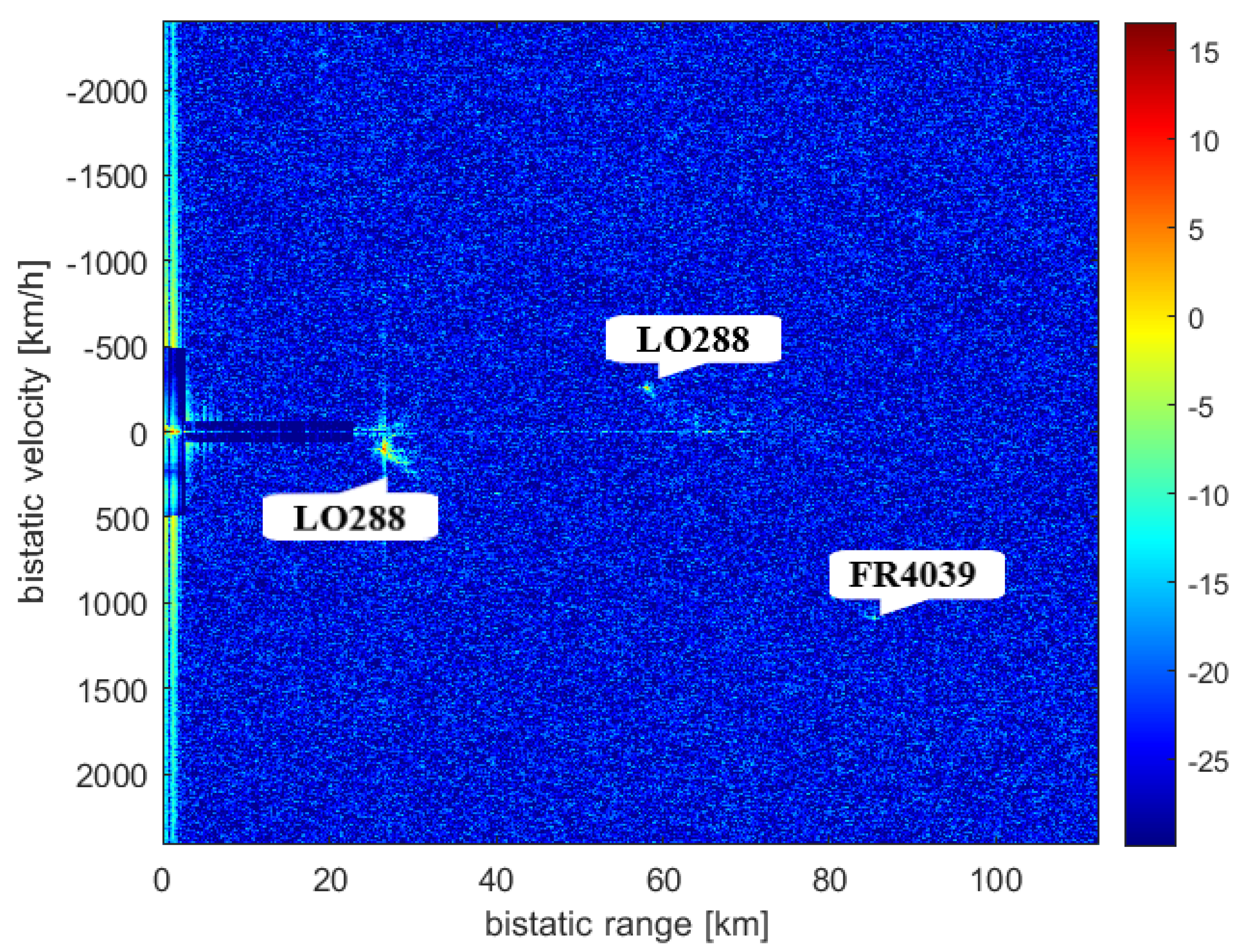1. Introduction
Passive coherent location (PCL) radars are a special type of radar that detect and track objects without emitting own waveform [
1,
2,
3,
4,
5]. Instead of possessing a cooperative transmitter they exploit different existing transmitters as illuminators of opportunity. The most popular illuminators of opportunity employed in passive radiolocation systems are analog and digital radio transmitters, digital television transmitters or even cellular base stations. The lack of own dedicated illuminator makes a passive radar undetectable and relatively inexpensive. The development of different telecommunication and broadcast networks with increasing number of transmitters has a strong effect on the popularity of passive radiolocation. A passive radar directly measures bistatic parameters of the target, i.e., a bistatic range and a bistatic velocity. Other target parameters such as position, velocity and effective radar cross section might be also estimated, using multiple illuminators of opportunity and/or multiple receivers.
LOFAR (LOw-Frequency ARray for radio astronomy) is an international network of radio-telescopes designed and constructed by ASTRON, the Netherlands Institute for Radio Astronomy. It started operating in 2012. Presently, LOFAR consists of 52 independent LOFAR stations, including 38 stations operated by ASTRON and 14 international stations located throughout Europe. Three of these stations are in Poland, near Poznań, Olsztyn and Kraków. Since a LOFAR station is a large sky-looking antenna array which can receive radio signals within the bands used by typical broadcasting transmitters, it is a good candidate for a passive radar receiver.
The purpose of this paper is to verify whether it is possible to use the signals received by a LOFAR station to detect aerial or space targets without any additional modification in a LOFAR station itself. Our goal is to achieve, in the near future, the ability to detect and track satellites and space debris using the existing LOFAR hardware infrastructure and relatively cheap passive radar technology, adding only adequate signal processing capabilities. The motivation for our research was that we obtained more than 300 km detection range of aerial targets using simple low-gain antennas as receivers, as well as the reports from papers presented by other authors describing their work on passive detection of meteors and space objects [
6,
7].
While LOFAR primarily explores the edge of the Universe and solves the mysteries of astronomy, it can also be used to observe at shorter distances, for example airplanes using passive radar technology. Furthermore, due to the size of LOFAR antenna and the number of LOFAR stations located in almost whole Europe, it is likely to observe the satellites using the network of LOFAR stations and the multiple illuminators of opportunity, located in different countries within Europe. The experiments presented in the paper show the detection of air targets using one LOFAR station with digital radio (DAB) transmitters of opportunity. The success of these experiments serve as a proof of concept, allowing the future extension towards detecting and tracking satellites with the same technique. This paper is an extension of a paper originally presented in 2020 at the 21st International Radar Symposium [
8]. Another paper related to particularities of beamforming of a LOFAR station for passive radiolocation purposes [
9] was also presented during the 21st International Radar Symposium in 2020.
3. Results of Experiments
The simplified experiments were conducted to verify the ability of the detection of targets by the passive radiolocation system using the LOFAR PL610 station, located in Borowiec near Poznan, as the receiver. The closest DAB+ transmitters were selected in order to use the LOFAR station in Borowiec for receiving both the reference and surveillance signals reflected from airplanes. During both experiments that were held in April and December 2019, two tiles out of all 96 HBAs were steered at the digital radio transmitters in Srem and Piatkowo (compare to
Figure 7), and the rest of them was directed towards the surveillance space—the air corridor above Swarzedz, where planes often occur. The TBB mode of signal acquisition, discussed in
Section 2.3, was used, so that the signals from the tiles could be recorded for about 1 s with 200 MHz sampling frequency. The data was next processed with use of Python and MATLAB.
To verify the results of experiments, in particular the estimated parameters of targets, a dedicated application was prepared. It makes use of the data from flightradar24 [
39], which includes flight tracking information. The dedicated application calculates the airplane bistatic parameters, i.e., the bistatic range and bistatic velocity for a given illuminator, from the flightradar24 data.
The targets that could be detected at the time of the measurement (14 April 2019) are seen in
Figure 9. The results of the CAF computation using the reference signal from Srem transmitter and the surveillance signal are presented in
Figure 10. Without applying the adaptive filtering for the removal of the direct-path signal and clutter, no target could be detected.
Figure 11 shows the CAF after adaptive filtering. The results emphasize the relevance of this stage of processing, since removing the direct-path transmitter signal and clutter allows detecting the presented targets. It is worth noticing that the total power of the surveillance signal was reduced using the adaptive clutter canceller by about 40 dB. The reduction of the direct-path signal leakage in the CAF, expressed as a difference of the CAF value for the zero bistatic velocity and zero bistatic range cell, before and after the adaptive filtering, reached almost 85 dB.
Due to the fact that both transmitters operate in a single frequency network, the measurement includes echoes for which the reference signal was from the illuminator in Piatkowo as well. It is generally possible to use multiple SFN emitters as the sources of reference signals; however, due to the greater power of Srem station we decided to ignore Piatkowo reference signal this time. The reference signal was received using the LOFAR tile no. 0 and the echo signal using the tile no. 8.
The results of the CFAR algorithm processing, with the threshold equal to 12 dB, are presented in
Figure 12. The CFAR algorithm compares the level of each cell to the averaged level of its neighbourhood, which is assumed to be noise, so that it could be decided whether that cell contains a target echo or not.
Figure 12 shows the detections of three objects: RYR25XF, SWR160, and RYR407N. Both the peaks related to the SWR160 and RYR25XF planes occurred twice as the result of the reflection of signals from both Srem and Piatkowo transmitters. The bistatic range and bistatic velocity of the airplanes for two illuminators are presented in
Table 1 (transmitter in Srem, S in
Figure 9) and
Table 2 (transmitter in Piatkowo, P in
Figure 9). Both tables show the comparison of the bistatic parameters estimated using the results of passive signal processing and the results calculated on the basis of the corresponding flightradar24 data. Because of different distances between LOFAR and transmitters (the signal from Piatkowo transmitter is 15.5 s delayed comparing to the signal from Srem transmitter), the estimated parameters required the appropriate correction, which was taken into account in
Table 2. The echoes from the RYR25XF plane, calculated using the data from flightradar24, should have appeared at the bistatic distances equal to 70.54 km (Srem) and 45.10 km (Piatkowo) and this target was detected by our passive radiolocation system at 70.65 km and 44.19 km, respectively. For the bistatic velocity of the RYR25XF plane, the results were −1173 km/h (on the basis of the flightradar data) and −1177 km/h (from passive radiolocation system) for the transmitter in Srem, and −1394 km/h and −1403 km/h for the transmitter in Piatkowo. The results obtained for all planes are in
Table 1 and
Table 2. The RYR407N plane was detected only for the illuminator in Piatkowo because of its position. Generally speaking, the bitatic parameters estimated by means of passive radiolocation are close to the bistatic parameters calculated on the basis of the flightradar24 data. Some discussion of the reasons for the differences is in the next section.
As was already mentioned, in the passive radiolocation, a target might be unambiguously located at the intersection of at least three ellipsoids [
31,
40]. Each ellipsoid corresponds to a pair of the transmitter and receiver. The position of the transmitters, as well as the receivers, should be known with high accuracy, as the position errors influence on the accuracy of target localisation [
41]. Taking advantage of the airplane’s altitude obtained from the flightradar24 data allowed us to reduce the problem to a two-dimensional case and estimate both the distance and azimuth, despite only two transmitter-receiver pairs were available. In this case, our goal is to find the intersection of two ellipses.
Figure 13 and
Figure 14 show the ellipses obtained for both transmitter-receiver pairs, i.e., Srem-LOFAR and Piatkowo-LOFAR. The ellipses intersections correspond to the positions of the RYR25XF and SWR160 planes, respectively. The LOFAR station (receiver) is in the center of the coordinate system both in
Figure 13 and
Figure 14, and the foci of the ellipses are in the places where there are the transmitters and the LOFAR station. The ellipses intersects in two points, so the target location requires choosing more probable intersection (
Table 3). When determining the target parameters, the height of the transmitter antenna centers was also taken into account, in Srem—250 m above the sea level, and in Piatkowo—128 m above the sea level. The described method of a target location could be applied only to those objects that were detected twice, and in our case, the measurement had to contain reflections whose sources were all available transmitters (
Table 1 and
Table 2). The RYR25XF plane, according to the flightradar data, was 39.94 km away with the azimuth of 297° to the LOFAR station, the intersection of the ellipses obtained by radar signal processing was at the distance 39.76 km and the azimuth of 298°. The second plane for which the echoes from two transmitters were found—SWR160, was supposed, according to flightradar24 data, to be at the distance of 27.32 km and 10° azimuth. As a result of intersecting the ellipses, the distance of 27.48 km and the azimuth equal to 10° were estimated.
The second experiment whose results are presented in this paper took place on 10 December 2019, and the situation in the air near the LOFAR station in Borowiec at the time of measurements is shown in
Figure 15. The technique of directing tiles in two directions: towards the transmitter in Srem and towards the air corridor above Swarzędz, was repeated. The recorded data were processed in the same way as the data from April 2019 and the CAF obtained in this case are presented in
Figure 16 and
Figure 17. Despite having been a few objects in the air, only two of them were detected: the LO288 plane echoes twice, as the result of reflection of signal emitted by both transmitters in Srem (
Table 4) and Piatkowo (
Table 5). Even though the threshold of CFAR algorithm was only 12 dB, it was impossible to detect the second echo of the FR4039 plane.
The LO288 plane was detected using the reference signal transmitted from Srem at the bistatic distance of 58.19 km and for the speed of −254 km/h. The bistatic range and velocity calculated on the basis of the flightradar24 data were 57.93 km and −249 km/h, respectively. The echo of this object was also detected for the signal from the transmitter in Piatkowo. The bistatic distance of 21.83 km and the bistatic velocity of 113 km/h were expected on the basis of the flightradar24 data, while the results of the parameters estimation resulted in 21.76 km and 100 km/h, respectively. Using two estimations of the LO288 plane parameters the appropriate ellipses were created and shown in
Figure 18. Consequently, the range towards LOFAR and azimuth could be calculated and the results are presented in
Table 6. The distance of the LO288 plane from the LOFAR station in Borowiec was determined, which is 30.41 km and the azimuth angle in relation to it is 348°—these values match almost exactly the distance and azimuth calculated on the basis of the data from the flightradar24.
Due to the short recording time, we were not able to estimate statistical measurement errors. In the experiments, the range cell was equal to 150 m and the velocity cell was equal 2.68 m/s (9.65 km/h). The majority of the differences between the PCL-based estimates and the flightradar24-based estimates, shown in
Table 1,
Table 2,
Table 4 and
Table 5, are less or comparable to the size of the corresponding cells. However, from our experience in passive radars, both the bistatic range and bistatic velocity errors can reach the level of 0.1–0.5 of the size of a resolution cell. The errors are inversely proportional to the root of the SNR after coherent integration [
5]. So after application of more sophisticated methods for signal processing and parameter estimation, we can expect the range errors of 15–75 m and the velocity errors of 0.3–1.2 m/s (1–5 km/h).
Another attempt was made to determine the speed of objects in the Cartesian system, based on the position of the objects and their bistatic velocities. However, to obtain correct results, signals from at least three transmitter-receiver pairs are needed, and this issue was postponed until further field trials.
4. Discussion and Conclusions
The analytical studies and the results of the conducted experiment show that a LOFAR station can work as the receiver in a passive radiolocation system. The analyses presented in the first part of the paper, in
Section 2.2, show that theoretical detection range is sufficient for the detection of satellites and it will be possible to detect and track space objects using a LOFAR station as the receiver and a set of distant transmitters as illuminators of opportunity. The experimental results presented in
Section 3, where aerial targets were detected using the close DAB+ transmitters, constituted a first proof of concept of the LOFAR usage for the passive radiolocation and encouraged taking next steps towards a LOFAR-based satellite tracking system. The obtained results, achieved by using only one tile of the LOFAR antenna, shows that with 0.5 s integration time it is possible to detect aerial targets at the distance about 80 km. The use of full antenna with circa about 20 dB greater gain than a single tile, and the longer integration time, for example adding more than 20 dB gain, will enable us to detect targets at more than 10 times longer distances, proving the theoretical analyses of the space target detection. An additional gain could be achieved by using several illuminators of opportunity and several LOFAR receiving stations.
The obtained results of the estimation of the target bistatic parameters as well as in Cartesian coordinates differ slightly for some targets from parameters calculated on the basis of the flightradar24 data. The differences result from simplifying assumptions taken into account in the processing of echo signals as well as from calculation of the reference parameters based on data from the flightradar24. The files with the flightradar24 data for particular planes are provided at relatively long intervals and the flight parameters had to be interpolated at the given moment when the measurement by means of LOFAR station was performed. On the other hand, the accuracy of the transponders which send the data about flights is limited and the data may contain some inaccuracies. Another reason of the occurring differences is related to the use of only two transmitter-receiver pairs instead of at least three pairs, and taking certain assumptions allowing determining approximate values of the target distance and azimuth. Although only two illuminators broadcasting in the radio-telescope frequency range were found near the LOFAR station, the obtained estimations of target parameters are in general satisfactory.
Since the presented concept was initially proved, the research on other possibilities related to the use of the LOFAR infrastructure in the passive radiolocation will be continued. Firstly, the possibilities of processing of LOFAR narrowband data recorded in the standard mode of LOFAR station operation, which is usually used by astronomers, should be investigated. Using this mode, we will be able to collect significantly longer signals, to use tracking and fusing techniques, and to perform statistical analyses. This mode seems to be a good basis for the development of the prototype of a real-time passive radiolocation system, which can be built as a result of some additions to the hardware of the LOFAR station and the development of the appropriate software for the end-to-end signal processing. In this mode, the LOFAR station provides digital signals in narrow 195.3125 kHz subbands, which should be combined to reconstruct the frequency bands of the signals transmitted by the illuminators of interest. Different frequency ranges are available in that mode, which is why those recordings may allow to make use of a greater number of illuminators. Another very important research area is related to beamforming for passive radar purposes. Some preliminary results on investigations on this subject were presented in [
9].
Further steps may include experiments with recordings derived from more LOFAR stations, so that a greater detection range could be achieved. Moreover, the possibility of using the LOFAR station at the same time for both radio astronomy and radiolocation purposes is going to be verified. The biggest challenge is to exploit transmitters that are not local to the LOFAR station bu at the distance of a few thousands of kilometres from LOFAR receiver. To achieve such goal the dedicated reference signal receivers have to be designed and synchronised with the LOFAR network. This is necessary because the distant transmitter direct signals cannot be received within the receiving LOFAR station (as it was done in the described experiment). The experiments in this area are scheduled for 2021.
Also, the use of a long integration time with an advanced motion compensation for orbital targets and the multistatic approach, where several LOFAR receivers and several transmitters of opportunity are exploited, are the necessary techniques to be mastered in the process of designing and constructing the system which may be expected to provide a low cost space surveillance above Europe. As these techniques are already in use, for example for sea targets [
42], the space surveillance system using the presented concept may be considered feasible in the light of the results presented.

